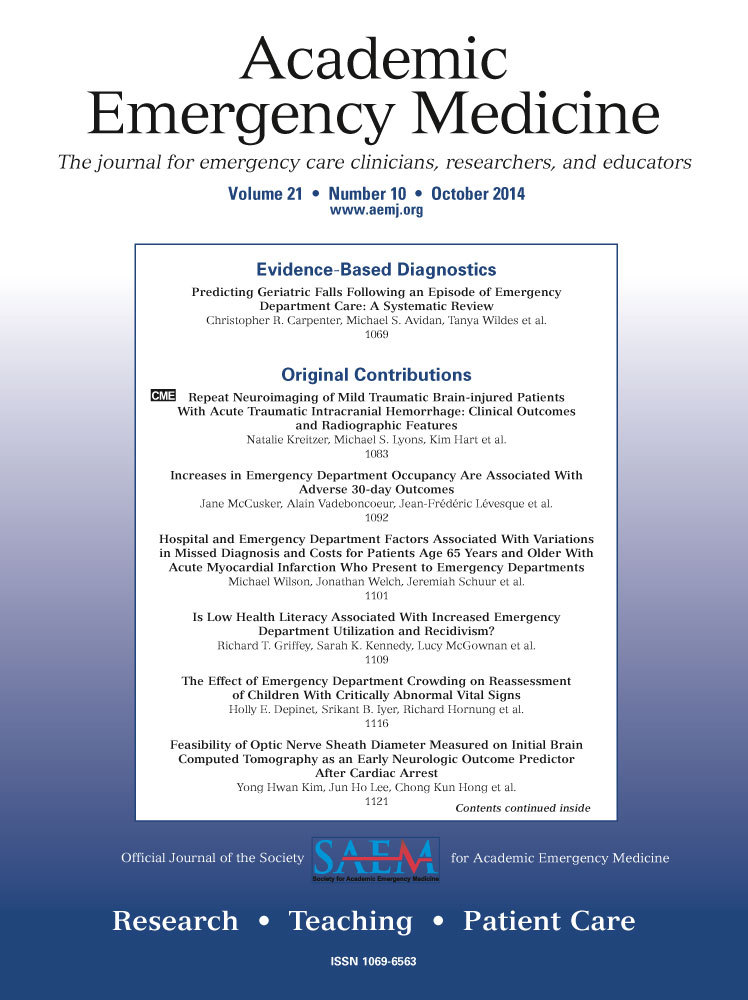Hospital and Emergency Department Factors Associated With Variations in Missed Diagnosis and Costs for Patients Age 65 Years and Older With Acute Myocardial Infarction Who Present to Emergency Departments
Factores del Servicio de Urgencias y del Hospital que Se Asocian con Variaciones en el Diagnóstico Erróneo y los Costes en Pacientes de 65 o más Años con Infarto Agudo de Miocardio Atendidos en los Servicios de Urgencias
Abstract
enObjectives
The objective was to measure the variation in missed diagnosis and costs of care for older acute myocardial infarction (AMI) patients presenting to emergency departments (EDs) and to identify the hospital and ED characteristics associated with this variation.
Methods
Using 2004–2005 Medicare inpatient and outpatient records, the authors identified a cohort of AMI patients age 65 years and older who presented to the ED for initial care. The primary outcome was missed diagnosis of AMI, i.e., AMI hospital admission within 7 days of an ED discharge for a condition suggestive of cardiac ischemia. Costs were defined as Medicare hospital payments for all services associated with and immediately resulting from the ED evaluation. The effect of ED and hospital characteristics on quality and costs were estimated using multilevel models with hospital random effects.
Results
There were 371,638 AMI patients age 65 and older included in the study, of whom 4,707 were discharged home from their initial ED visits and subsequently admitted to the hospital. The median unadjusted hospital-level missed diagnosis percentage was 0.52% (interquartile range [IQR] = 0 to 3.45%). ED characteristics protective of adverse outcomes include higher ED chest pain acuity (adjusted odds ratio [aOR] = 0.23, 99% confidence interval [CI] = 0.19 to 0.27) and American Board of Emergency Medicine (ABEM) certification (aOR = 0.60, 99% CI = 0.50 to 0.73). Protective hospital characteristics include larger hospital size (aOR = 0.46, 99% CI = 0.37 to 0.57) and academic status (aOR = 0.74, 99% CI = 0.58 to 0.94). All of these characteristics were associated with higher costs as well.
Conclusions
The proportion of missed AMI diagnoses and cost of care for patients age 65 years and older presenting to EDs with AMI varies across hospitals. Hospitals with more board-certified emergency physicians (EPs) and higher average acuity are associated with significantly higher quality. All hospital characteristics associated with better ED outcomes are associated with higher costs.
Resumen
esObjetivos
El objetivo fue la medición conjunta de la variación en el diagnóstico erróneo y los costes de la atención del infarto agudo de miocardio (IAM) en los pacientes mayores atendidos en los servicios de urgencias (SU) e identificar las características del SU y del hospital asociadas con esta variación.
Metodología
Se identificó una cohorte de pacientes de 65 o más años con IAM que se atendieron inicialmente en un SU usando las historias de pacientes ingresados y dados de alta de Medicare 2004–2005. El resultado principal fue el diagnóstico erróneo de IAM (por ejemplo: ingreso en el hospital por IAM en los primeros 7 días tras un alta del SU por una patología sugestiva de isquemia cardiaca). Los costes se definieron como pagos de Medicare al hospital por todos los servicios asociados con, e inmediatamente derivados de la evaluación del SU. El impacto de las características del SU y del hospital en la calidad y los costes se estimaron mediante modelos multinivel con efectos aleatorios del hospital.
Resultados
Hubo 371.638 pacientes de 65 o más años con IAM incluidos en el estudio, de los cuales 4.707 fueron dados de alta tras la visita inicial al SU y posteriormente ingresados en un hospital. El porcentaje mediano no ajustado al nivel del hospital de diagnóstico erróneo fue de un 0,52% (rango intercuartílico [RIC] 0 a 3,45%). Las características protectoras del SU del SU protectoras de resultados adversos incluyeron una mayor gravedad del dolor torácico en el SU (odds > ratio ajustada [ORa] 0,23, intervalo de confianza [IC] 99% = 0,19 a 0,27), y la certificación del (urgenciológo) (ORa 0,60, IC 99% = 0,50 a 0,73). Las características protectoras del hospital incluyeron un hospital de mayor tamaño (ORa 0,46, IC 99% = 0,37 a 0,57) y universitario (ORa 0,74, IC 99% = 0,58 a 0,94). Todas estas características se asociaron también con mayores costes.
Conclusiones
La proporción de diagnóstico erróneo de IAM y los costes de la atención para los pacientes de 65 o más años que se atienden en los SU varían entre los hospitales. El hospital con más (urgenciológos) certificados y mayor promedio de gravedad asocia significativamente mayor calidad. Todas las características del hospital se asociaron con mejores resultados del SU y con mayores costes.




